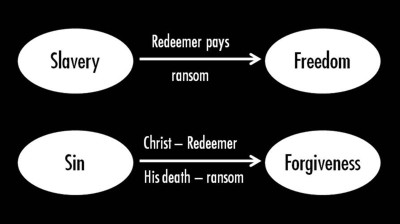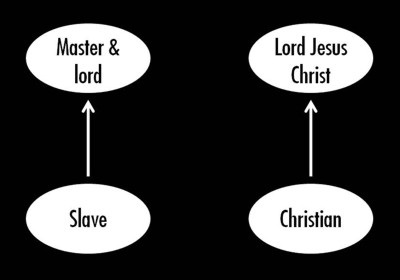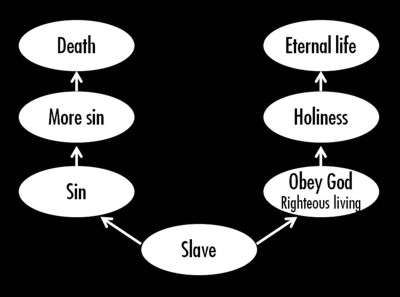Slavery and freedom
We are all slaves to what we follow
Immigrants to Australia are told we have freedom of speech, freedom of association, freedom of assembly, freedom of religion, and freedom of movement. We are a democracy with laws against discrimination based on race, gender, disability or age. People are autonomous and are generally free to live as they want to. Therefore, we don’t have slavery where people are owned by their master and are totally dependent on them. But are we really free?
Slaves of sin
Jesus said we are not as free as we think. When He was on earth, He told the Jews “If you hold to my teaching, you are really my disciples. Then you will know the truth, and the truth will set you free” (Jn. 8:31-32NIV). They objected: we’ve never been slaves, so how can we be set free? They had forgotten about the Babylonian captivity. Also, in Jesus’ time they were ruled by the Romans. But Jesus explained “everyone who sins is a slave to sin” (v.34).
So Jesus describes two types of people. Those who are slaves and those who are free. First the slaves. He says whoever practices sin is a slave of sin. As slaves have masters, such people are owned and controlled and committed to sin. They can’t break free by their own strength. Sinners can’t escape sin. Are we like them; slaves of sin, ignorance, false teaching, and superstition?
Second the freed. But “if the Son (Jesus Christ) sets you free, you will be free indeed” (v.36). When a person trusts in Christ’s sacrificial death, they are freed from the slavery of sin. The evidence of this is that they “hold to my teaching”. They follow Jesus. Is there enough evidence to show that we follow Jesus? Jesus calls these people sons.
Are you a slave or a son (v.35)? Here we see that because slavery was common in Biblical times, the Bible often uses it to illustrate spiritual truths. And there are more to come.
Freedom purchased – Redemption
Slavery can involve hard work and cruelty. Slaves seek freedom from their slavery. Let’s look at two examples from the Old Testament. First, when God promised to free the Israelites from slavery in Egypt, He said, “I am the Lord, and I will bring you out from under the yoke of the Egyptians. I will free you from being slaves to them, and I will redeem you with an outstretched arm and with mighty acts of judgment” (Ex. 6:6).
To redeem means to buy back or to release by means of a payment. It costs. This was illustrated in the 10th plague when the firstborn across Egypt died, except for the Israelites. In this case the payment was the lamb that died instead of the first born (Ex. 13:13-15). So God used a mighty display of power (described as “an outstretched arm”) to release them from slavery. He also judged the Egyptians in the plagues and when the army and their chariots and horses were lost in the Red Sea.
The second example is how debt slaves could be freed from their slavery. When people fell into debt they could sell some or all of their family into slavery so they could work to eventually repay the debt (Lev. 25:47-49). Such debt slavery was a form of welfare. If a relative was able to repay the debt, then a debt slave could be released from their master. The price was determined by the number of years remaining until the year of jubilee when debts were cancelled (Lev. 25:50-52). This person was called the redeemer and the money paid was called the ransom (Lev. 19:20). The redeemer rescues people from a bad situation. In this case they were freed from slavery as shown in the diagram.
 The Bible uses this illustration to describe what Jesus did. The Jews thought that Jesus would redeem them from Roman domination (Lk. 24:21), but God had a different redemption in mind (Rom. 3:24).
The Bible uses this illustration to describe what Jesus did. The Jews thought that Jesus would redeem them from Roman domination (Lk. 24:21), but God had a different redemption in mind (Rom. 3:24).
“Christ redeemed us from the curse of the law by becoming a curse for us, for it is written: ‘Cursed is everyone who is hung on a pole’” (Gal. 3:13). The curse of the law is death. That’s the main punishment for not keeping the commandments (with diseases & disasters Lev. 26:14-45; Dt. 11:26-28; 27:14-26; 28:15-67; 29; 19-28). Here we see that Jesus took the punishment instead so the Jewish believers were completely delivered from the law. He came “to redeem those under the law” (Gal. 4:5). That was the price paid for our deliverance from sin as well. The Bible says, “You were bought at a price” (1 Cor. 6:20; 7:23).
 It’s like being released from slavery or kidnapping and set free. Jesus came to “give His life as a ransom for many” (Mt. 20:28; Mk. 10:45) and “as a ransom for all people” (1 Tim. 2:6) – where the NLT says, “He gave His life to purchase freedom for everyone”. This redemption results in “forgiveness of sins” (Eph. 1:7; Col. 1:14). This means we can be released from the eternal penalty of our sins. The diagram shows that what Jesus did is similar to when a debt slave is redeemed by a ransom. Christ is the Redeemer and His death is the ransom paid.
It’s like being released from slavery or kidnapping and set free. Jesus came to “give His life as a ransom for many” (Mt. 20:28; Mk. 10:45) and “as a ransom for all people” (1 Tim. 2:6) – where the NLT says, “He gave His life to purchase freedom for everyone”. This redemption results in “forgiveness of sins” (Eph. 1:7; Col. 1:14). This means we can be released from the eternal penalty of our sins. The diagram shows that what Jesus did is similar to when a debt slave is redeemed by a ransom. Christ is the Redeemer and His death is the ransom paid.
The Bible says that Jesus died “to redeem us from all wickedness” (Tit. 2:14). We are delivered from being dominated by sin. From being slaves to sin. From being addicted to sin. We are also redeemed from our “empty way of life” (1 Pt. 1:18). All this is summarised as “Christ died for our sins” (1 Cor. 15:3). The Redeemer (Christ) paid the ransom (death) to release us from being slaves to sin. So Jesus is a Redeemer who can rescue us from slavery to sin.
Jesus as God’s slave
But Jesus was not just a Redeemer. When God promised the Messiah in Isaiah, He was called “my servant” (Isa. 42:1; 49:3, 6; 52:13; 53:11). “When he sees all that is accomplished by his anguish, he will be satisfied. And because of his experience, my righteous servant will make it possible for many to be counted righteous, for he will bear all their sins.” (Isa. 53:11NLT).
The Hebrew word translated as “servant” in this verse is ebed (Strong’s #5650), which means “slave”. It’s clear that these passages about the servant in Isaiah (Isa. 42:1-7; 49:1-7; 52:13-53:12) refer to the Lord Jesus because He was to experience suffering and be exalted (Isa. 52:13; 53:11). The image is of an obedient slave. This obedience was shown in the garden of Gethsemane when He prayed “your will be done” (Mt. 26:42). The Bible also says that He took “the very nature of a servant” when He lived as a human being (Phil. 2:7). The Greek word translated as “servant” in this verse is doulos (Strong’s #1401), which means “slave”.
That’s amazing! The one we call Lord was like a slave! The Redeemer was God’s slave. This means that redemption through Christ was God’s idea. It also means that Jesus obeyed God the Father as a slave obeyed their master. He is the greatest example of obedience and faithfulness for those who have been redeemed from slavery to sin to be God’s sons.
Slaves of Christ
What about those who have been redeemed? The Bible says that Peter, James, Paul and Epaphras were slaves of Jesus Christ. (Rom. 1:1; Col. 4:12; Jas. 1:1; 2 Pt. 1:1). Elsewhere Christians are called “slaves of Christ” who did the will of God from their heart (Eph. 6:6). What does this mean?
 Slaves serve their master who is their lord as shown in the diagram. Jesus Christ has paid the price to release Christians from slavery to sin and Satan and they are now His slave as shown in the diagram. They now have a new master. He is their Lord and they are to serve Him. This applies to people from all nations as Peter told the Gentile Cornelius that Jesus Christ is “Lord of all” (Acts 10:36). The Greek word translated “Lord” was kyrios (Strongs #2962), which means supreme in power and authority. It’s a title of honor and respect used by slaves to their masters (Mt. 13:27). Like a soldier says “Sir” to their commander. To confess Jesus as “Lord” is to say He is our “master” and “owner” and we are His slave. Thomas called Jesus, “My Lord and my God!” (Jn. 20:28). In the New Testament, both Jesus Christ and God the Father are called “Lord”.
Slaves serve their master who is their lord as shown in the diagram. Jesus Christ has paid the price to release Christians from slavery to sin and Satan and they are now His slave as shown in the diagram. They now have a new master. He is their Lord and they are to serve Him. This applies to people from all nations as Peter told the Gentile Cornelius that Jesus Christ is “Lord of all” (Acts 10:36). The Greek word translated “Lord” was kyrios (Strongs #2962), which means supreme in power and authority. It’s a title of honor and respect used by slaves to their masters (Mt. 13:27). Like a soldier says “Sir” to their commander. To confess Jesus as “Lord” is to say He is our “master” and “owner” and we are His slave. Thomas called Jesus, “My Lord and my God!” (Jn. 20:28). In the New Testament, both Jesus Christ and God the Father are called “Lord”.
This illustration is consistent with the Old Testament where the Israelites were said to be God’s slaves. But they were unfaithful. As the Jews were to be devoted to God and Christ was devoted to His Father, so Christians are to be devoted to following and serving Christ.
Slaves of obedience and righteous living
We have looked at being slaves of sin and slaves of Christ. We are all slaves to what we follow. Sin and Christ are like two masters. The Bible teaches that we are slaves to one or the other. Its main message is that we have a choice of master. Paul describes this in Romans 6:
“Since God’s grace has set us free from the law, does that mean we can go on sinning? Of course not! Don’t you realise that you become the slave of whatever you choose to obey? You can be a slave to sin, which leads to death, or you can choose to obey God, which leads to righteous living. Thank God! Once you were slaves of sin, but now you wholeheartedly obey this teaching we have given you. Now you are free from your slavery to sin, and you have become slaves to righteous living.
Because of the weakness of your human nature, I am using the illustration of slavery to help you understand all this. Previously, you let yourselves be slaves to impurity and lawlessness, which led ever deeper into sin. Now you must give yourselves to be slaves to righteous living so that you will become holy.
When you were slaves to sin, you were free from the obligation to do right. And what was the result? You are now ashamed of the things you used to do, things that end in eternal doom. But now you are free from the power of sin and have become slaves of God. Now you do those things that lead to holiness and result in eternal life. For the wages of sin is death, but the free gift of God is eternal life through Christ Jesus our Lord.” (Rom. 6:15-23NLT)
Paul says that we are slaves to what controls us (v.16). No one is autonomous. We are either slaves of sin or slaves of Christ. In the first case, sin enslaves by spreading. It’s addictive. Sin can’t be avoided or overcome. Paul said, “Although I want to do good, evil is right there with me” (Rom. 7:21). Sin leads to more sin and being deeper into sin (v.19). It means we do things that we are ashamed of (v.21). And sin results in death. Moral death. Physical death. Eternal punishment and separation from God. This is summarised in the diagram.
The only alternative is to obey God so that sin no longer dominates. Believers have a new master! They are slaves of obedience and righteous living, which leads to holiness and eternal life. This choice is also shown in the diagram.
Our choices
Because slavery was common in Biblical times, the Bible often uses it to illustrate spiritual truths. We have seen that because we are all controlled by something, there is no such thing as absolute autonomy and freedom. Instead there are choices to be made. Jesus said that we can’t serve two masters like God and money (Mt. 6:24). We can’t follow each way. It’s either one or the other.
We are born as slaves to sin. If we remain that way this leads to more sin and death and the consequence is eternal punishment. But we can be rescued from this situation. God has sent a redeemer who has paid the price so we can be God’s sons instead of slaves to sin. The consequence is eternal life instead of eternal punishment. Have you accepted this offer? It’s the most important decision in our lives.
Christians are redeemed from their previous way of life. They have a new master and Lord. Now they should obey and serve Christ like a slave does to a master and like Jesus obeyed and served God. This leads to holiness and the consequence is eternal life.
As we are all slaves to what we follow, let’s choose Christ as our master and Lord and obey and serve Him daily.
The choice Christians face each day is do I serve sin or do I serve God? Of course it’s best to follow our new master, not the old one. If we lapse, then we can confess our sin and repent by changing our behaviour.
Our choices have consequences. We reap what we sow and harvest what we plant (Gal. 7:7-10). Let’s remember, if we have trusted in the Lord Jesus, then we are His slaves. Then we will seek to please Him and He will work in our lives.
Also see – Does the Bible condone slavery? Part 1 (OT)
Does the New Testament condone slavery?
Written, July 2013
This entry was posted on July 9, 2013 by George Hawke. It was filed under Christian, Christian living, Spiritual and was tagged with freedom, illustration, liberty, metaphor, obedience, redeem, redemption, righteous living, sin, slave, slavery, slaves.






Leave a comment